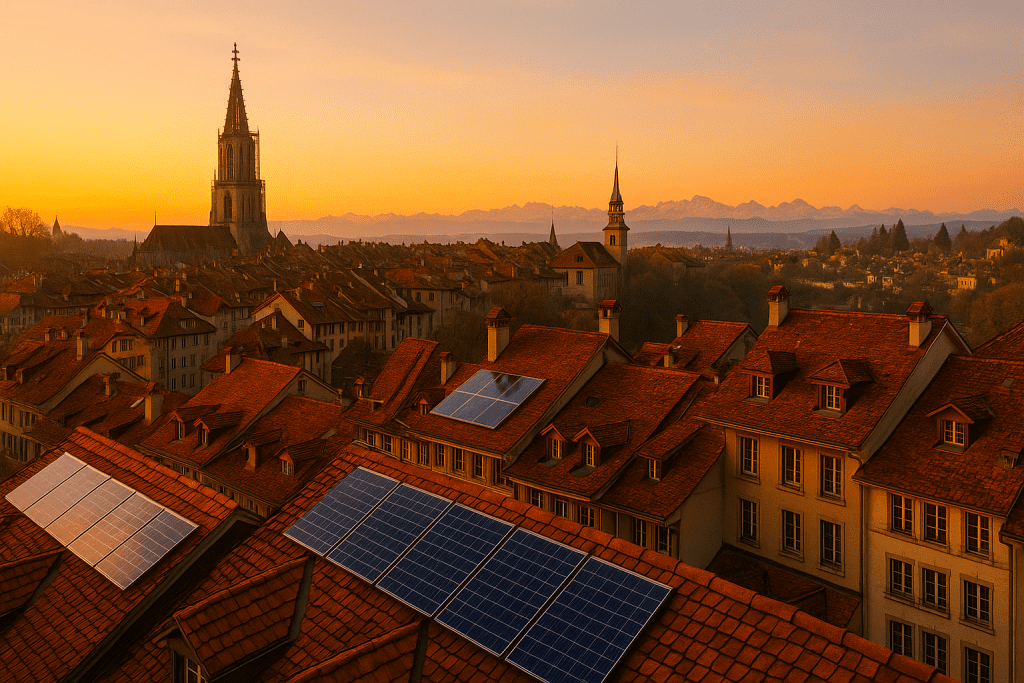Solar Power in Canton Bern: Shine Brighter, Spend Less

Bern’s Solar Potential: More Sun Than You Think
Picture the rolling hills of the Emmental or the majestic peaks of the Bernese Oberland. Now, imagine them bathed in sunlight that rivals the intensity of Madrid. It’s not an exaggeration. According to data from MeteoSwiss, the Canton of Bern is a powerhouse of solar potential.
The Mittelland, the central plateau region of the canton, receives an impressive average of 1,100 kilowatt-hours per square meter (kWh/m²) of solar irradiation annually. As you ascend into the clearer alpine air of the Oberland, this figure climbs even higher, often exceeding 1,200 kWh/m². This abundance of sunshine provides a robust foundation for high-yield photovoltaic (PV) systems.
To put this into perspective, Bern’s solar potential is approximately 15% greater than Berlin’s and 10% more than Paris’s. This climatic advantage means that a well-positioned solar array in Bern can generate significantly more electricity than a comparable system in many other major European cities, making it a highly productive and financially attractive investment.
Want to skip the guide and go straight to checking your roof’s earning potential?
Get a Free Solar Proposal for Your RoofPV Installation Practices: Roof, Ground & Permits
Installing a solar energy system in Canton Bern is a streamlined process, thanks to clear regulations. However, understanding the rules for different installation types and the permitting process is key to a smooth project.
Roof-Mounted Systems & The Notification Process
For the vast majority of residential and commercial buildings, installing solar panels on the roof does not require a formal building permit. Instead, it falls under a simplified notification procedure (Meldeverfahren). According to Article 18a of the Federal Spatial Planning Act, “sufficiently adapted” solar installations on roofs are exempt from permits, provided they meet certain criteria:
- They do not significantly protrude from the roof (typically no more than 20cm).
- They are installed as a compact, uniform surface.
- They do not affect cultural or natural monuments of national or cantonal significance.
Even if your project is permit-free, you are still required to notify the local building authority before starting work, often done through the canton’s eBau online platform.
When is a Full Building Permit Required?
A full building permit (Baubewilligung) is necessary in specific cases:
- Protected Buildings: If your property is listed as a protected heritage site (schützenswertes Inventarobjekt).
- Designated Protection Zones: Installations within specific cantonal or municipal protection zones may require a permit.
- Fassadenanlagen (Facade Installations): While becoming more popular, installations on building facades often require a permit, and for high-rise buildings, a fire safety assessment is mandatory.
Ground-Mounted and Alpine Systems
While less common for residential properties, ground-mounted systems are an option for agricultural or commercial sites with available land. The permitting for these is more complex and site-specific. In a push to secure winter energy supply, the federal government and Canton Bern have created streamlined approval processes for large-scale alpine solar plants, recognizing their potential to generate crucial electricity when hydro-power is less productive.

System Size & Yield in the Canton of Bern: Plan Smart, Build Big
In the past, solar systems in Bern were often designed to match the building’s current electricity usage—maximizing self-consumption and helping owners reduce their electricity bills. But with solar technology becoming more efficient and regulatory frameworks improving, this approach often results in underused rooftops and limited long-term benefits.
Why fully utilizing your rooftop capacity makes sense in Bern
There are three compelling reasons to install a system that uses the full solar potential of your roof:
1. Future-proof your energy supply
Solar modules today can reliably produce power for 30 to 40 years, meaning your system should be built with long-term trends in mind. As more households and businesses in Bern switch to electric heating, e-mobility, and smart appliances, the demand for electricity is expected to rise steadily. A system based only on today’s usage may quickly become insufficient.
2. Retrofitting later is often inefficient
Adding more capacity later sounds easy—but in reality, it means new permits, possible changes to your inverter, extra installation costs (such as scaffolding), and delays. Planning for full-scale installation from the start helps you benefit from economies of scale and minimizes technical and administrative complications later on.
3. New rules allow you to sell surplus electricity more effectively
Thanks to energy-sharing models like ZEV (Zusammenschluss zum Eigenverbrauch), vZEV, and LEG (Lokale Elektrizitätsgemeinschaft)—which are also encouraged in Bern—you can now sell unused solar power not just to your local utility, but also to tenants, neighbors, or local cooperatives. This turns your roof into an active income-generating asset, especially in multi-unit or commercial buildings.
If your budget is limited, flexible solutions exist
Can’t finance a large system up front? In Bern, many providers offer leasing, Power Purchase Agreements (PPA), or roof rental models where you can benefit from your roof space without needing to invest. These are increasingly popular in rural Bern, where larger rooftops (e.g. on farms) offer strong solar returns.
Tailor your system to your building’s usage
The most profitable solar energy is the electricity you use directly. To make the most of it, review your electricity bills from the past year, or request a load profile from your local utility (like BKW or Energie Wasser Bern). Try to align high-consumption activities—like EV charging or heating water—with sunlight hours.
Even with optimization, self-consumption typically caps at around 30% for systems without a battery. To reach 80–90% self-sufficiency, you’ll need to install energy storage to use solar power at night or on cloudy days.
Cost Breakdown & Real-World Payback in Canton Bern
Investing in solar power is more accessible than ever. Understanding the costs and the financial returns is essential for making an informed decision.
Typical Cost Breakdown
The total cost of a turnkey PV system in Switzerland has become increasingly competitive. For a standard 10 kWp rooftop installation, you can expect an investment of around CHF 24,000 to CHF 32,000 before subsidies. This price typically includes:
- Solar Modules: The panels themselves.
- Inverter: The device that converts DC power from the panels to usable AC power for your home.
- Mounting System: The framework that secures the panels to your roof.
- Installation & Labor: Including scaffolding, electrical work, and grid connection.
- Planning & Documentation: Engineering, notification / permit procedures, subsidy applications and safety reports.
Adding a battery storage system (typically 8-15 kWh) can add CHF 8,000 to CHF 15,000 to the initial cost.
A Real-World Payback Example: The Muster Family
Let’s consider the fictional Muster family in a single-family home in the Bernese Mittelland.
- System: 10 kWp rooftop installation (without battery).
- Gross Cost: CHF 28,000.
- Federal Subsidy (Pronovo): CHF 3,600 (Calculated as 10 kWp x CHF 360/kW).
- Cantonal/Municipal Subsidy (e.g., City of Bern): Up to CHF 80/kW, totalling CHF 800.
- Net Investment: CHF 28,000 – CHF 3,600 – CHF 800 = CHF 23,600.
This investment can often be deducted from taxable income, providing further significant savings.
With current electricity prices, the system can generate annual savings of over CHF 1,800. This leads to a simple payback period of approximately 10 to 13 years, after which the electricity is virtually free.
Find out how you can profit from your rooftop solar without upfront investment costs.
Get a Free Solar Proposal for Your RoofMoreover, studies have consistently shown that a PV system increases a property’s market value, often by 4-6%, making it an investment that pays dividends both in savings and in equity.
The Local Solar Market: Installers & Flagship Projects
The solar market in Canton Bern is mature and competitive, offering a wide choice of qualified installers and high-quality components.
How to Choose the Right Installer
Selecting a reputable installer is the most critical step. Use this checklist to vet potential partners:
- Local References: Ask for at least three recent projects completed within Canton Bern that you can contact or view.
- Tier-1 Components: Insist on written confirmation that they will use Tier-1 solar modules and inverters from reputable manufacturers.
- Comprehensive Quote: The offer should be itemized, clearly breaking down the costs for hardware, labor, and other services.
- Warranties and Guarantees: Check the product warranties (typically 15-25 years for modules) and the installer’s workmanship warranty.
Subsidies & Incentives: Turning Sunshine Into Swiss Francs
Switzerland and Canton Bern offer attractive financial incentives that significantly reduce the net cost of a solar installation.
Federal One-Time Remuneration (Einmalvergütung)
The primary federal subsidy is a one-time payment from Pronovo, the accredited body for processing federal grants. For small installations (under 100 kWp), this is known as KLEIV. The rates are periodically adjusted, but as of early 2025, they are:
- Standard Rooftop Systems: A performance-based contribution of around CHF 360 per kWp for the first 30 kW.
- Building-Integrated Systems (BIPV): A higher rate of around CHF 400 per kWp is offered for aesthetically integrated systems.
- There are additional bonuses, such as
- Neigungswinkelbonus
- Höhenbonus
- Parkflächenbonus
Calculate your subsidy in the Pronovo calculator
An application for the Pronovo subsidy can only be submitted after the system has been commissioned and certified.
Cantonal and Municipal Support
Canton Bern’s own energy promotion program complements the federal subsidies. Additionally, several municipalities offer their own grants. For example:
- City of Bern: Through Energie Wasser Bern (EWB) and its eco-fund, property owners in the city can receive an additional contribution, currently set at CHF 80 per kWp for systems up to 30 kWp or a lump sum of CHF 2,400 for larger systems.
Tax Deductions
A significant financial benefit is the ability to deduct the entire investment cost of a new photovoltaic system from your taxable income in most cantons, including Bern. This one-time deduction can result in thousands of francs in tax savings, effectively acting as a major subsidy.
Tariffs, Feed-in & Net-Metering Rules
Understanding how you are billed for electricity and compensated for your solar exports is fundamental to the economics of your PV system.
The Structure of Your Electricity Bill
Your electricity tariff is composed of three main parts:
- Energy Tariff: The cost of the electricity itself.
- Grid Usage Tariff: The fee for using the local and national grid infrastructure to transport the power.
- Taxes and Levies: Various communal and federal charges.
When you self-consume your solar power, you avoid all three of these costs. When you export power, you are only compensated for the energy value, not the grid fees or taxes. This is why a self-consumed kWh is significantly more valuable than an exported one.
Feed-in Tariffs in Bern
Each utility sets its own feed-in tariff (Einspeisevergütung) for the surplus solar energy you export to the grid. These rates can vary.
- BKW: As one of the canton’s largest utilities, BKW has adjusted its feed-in tariffs. As of mid-2024, they increased the remuneration for certified origin labels (HKN) to 3.5 Rp./kWh, on top of the market rate for the energy.
- Energie Wasser Bern (ewb): For 2025, EWB has set an minimum feed-in tariff of 14.8 Rp./kWh, which is notably high and supports the profitability of solar installations in the city. If the guarantees of origin (HKN) are submitted to EWB, additional remuneration will be paid at market prices.
Important Note: Switzerland does not practice “net-metering,” where the meter spins backward. Instead, consumption and injection are measured separately, and you are billed for what you draw from the grid and paid for what you feed in.
Solar Contracting Options in Bern: Ownership, Leasing, and Beyond
Whether you live in the city of Bern, in the Oberland, or on the rural plateau, there are multiple ways to benefit from solar power—without always needing to finance a system yourself. From traditional ownership to shared investment models, here’s how you can take part in the solar energy transition in Canton Bern:
1. Full Ownership
This is the most common approach for homeowners across Bern. You buy the system outright and benefit from all the available federal and cantonal subsidies, feed-in payments, and energy savings. Over the system’s lifespan, ownership typically yields the strongest financial return.
• Best for: Owners of single-family homes or commercial buildings with sufficient capital or access to financing.
2. Leasing Model
In a lease model, a solar provider installs and owns the system on your roof. You pay a monthly leasing fee to use the electricity, often without any upfront cost. The installer usually retains the subsidies and feed-in revenues. Some leasing contracts allow you to purchase the system after a few years.
- Best for: Budget-conscious homeowners who want to switch to solar without investing heavily up front.
3. Power Purchase Agreement (PPA)
Under a PPA, the solar provider builds and maintains the system and sells you the generated electricity at a fixed rate—usually lower than your current grid tariff. This is an increasingly popular model in co-owned buildings (STWEG), multi-family houses, or agricultural estates in Bern where shared financing would be complex.
- Best for: Multi-tenant buildings, businesses, or farms seeking low-risk access to solar energy.
4. Roof Rental (Dachmiete)
If you own a large roof that you don’t need for your own energy, you can lease it out to a third-party provider. They build and operate the PV system, sell the electricity externally, and pay you rent for using your rooftop. This model requires no investment from your side and is especially well-suited to rural Bernese properties, such as barns or warehouses.
- Best for: Owners of unused or oversized roofs who want to generate passive income.
5. Hybrid Models
In Bern, community energy projects and hybrid models are gaining traction. Some providers allow you to combine roof rental with partial investment, meaning you can earn both a fixed rent and a share of the profits from energy sales.
- Best for: Property owners and communities looking for flexible participation with scalable financial returns.
Your 7-Step Roadmap to a Bern PV System
From initial thought to generating your own clean power, the process can be broken down into seven clear steps. An experienced installer will guide you through this journey, which typically takes 8-12 weeks.
- Initial Assessment & Consultation: Contact a certified installer for a free, no-obligation roof assessment. They will analyze your roof’s suitability (orientation, shading, condition) and discuss your energy needs.
- Quotation & Installer Selection: You will receive a detailed, itemized quote. It’s wise to get 2-3 quotes to compare offers, but prioritize quality and reputation over the lowest price.
- Contract & Financing: Once you select an installer, you’ll sign a contract. This is also the time to finalize any financing if needed.
- Official Notification & Grid Application: Your installer will handle the necessary paperwork, including submitting the Meldeformular (notification form) to your local municipality via the eBau platform and the grid connection application to your utility (e.g., BKW, ewb).
- Installation: The physical installation is surprisingly quick. A team will set up scaffolding and typically mount the panels and inverter within 2-3 days for a smaller residential system.
- Grid Connection & Inspection: After installation, the utility will replace your old meter with a smart meter that measures both consumption and injection. A final safety inspection (SiNa) is performed to certify the system is safe and compliant.
- Commissioning & Monitoring: With the flip of a switch, your system goes live! Your installer will provide you with access to a monitoring portal or app, allowing you to track your energy production and consumption in real-time. Don’t forget to submit your documents to Pronovo for the federal subsidy at this stage.
Conclusion – How to make the most out of PV in Bern
The era of solar power in Canton Bern is no longer a distant vision; it’s a present-day financial and ecological reality. Blessed with exceptional sunshine, supported by robust federal and cantonal incentives, and driven by the economic logic of rising electricity prices, installing a photovoltaic system has transitioned from an environmental statement to one of the smartest investments a property owner can make.
The future of solar in Bern is even brighter. Groundbreaking developments are on the horizon:
- Local Energy Communities (ZEV): The new Electricity Act simplifies the formation of self-consumption communities (Zusammenschluss zum Eigenverbrauch), allowing neighbors to share solar power, bypass grid fees, and dramatically increase efficiency. Virtual ZEVs (vZEV), possible since January 2025, further simplify this by using existing grid infrastructure.
- Agrivoltaics: Pilot projects in regions like the Emmental are proving that agriculture and solar production can coexist, with panels providing shade for crops while generating power.
- Vehicle-to-Grid (V2G): Soon, your electric vehicle will not just consume power but also serve as a household battery, feeding energy back into your home during peak hours to further slash costs.
Your roof is an underutilized asset waiting to be transformed into a personal power plant and a center for profit. The first step is simple: invite a Swissolar-certified installer for a free assessment. In just a few months, you could be waking up not just to the Bernese sun, but to the quiet, satisfying knowledge that every ray of light is brightening your future and lightening your expenses.
Ready to start? Whether you want to own the system or simply rent out your roof for passive income, Solergy can help.
Get a Free Solar Proposal for Your RoofNot in Bern?
Discover solar opportunities and incentives in your canton.





